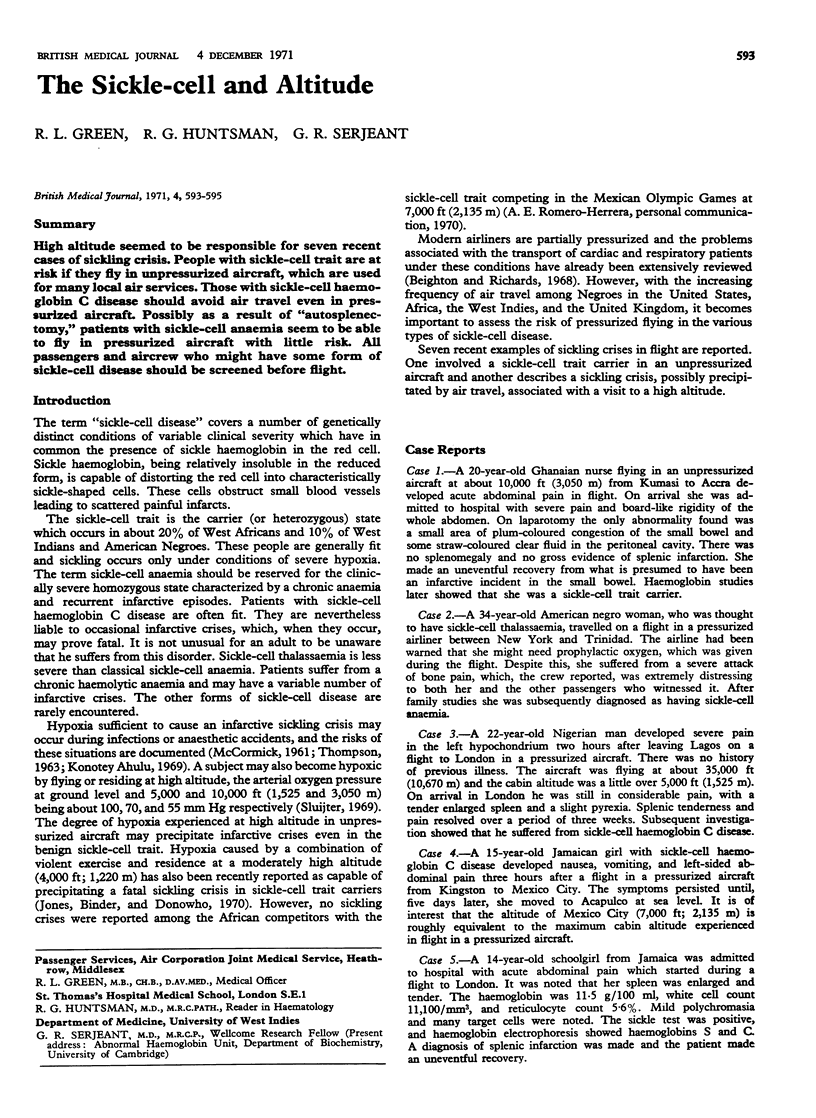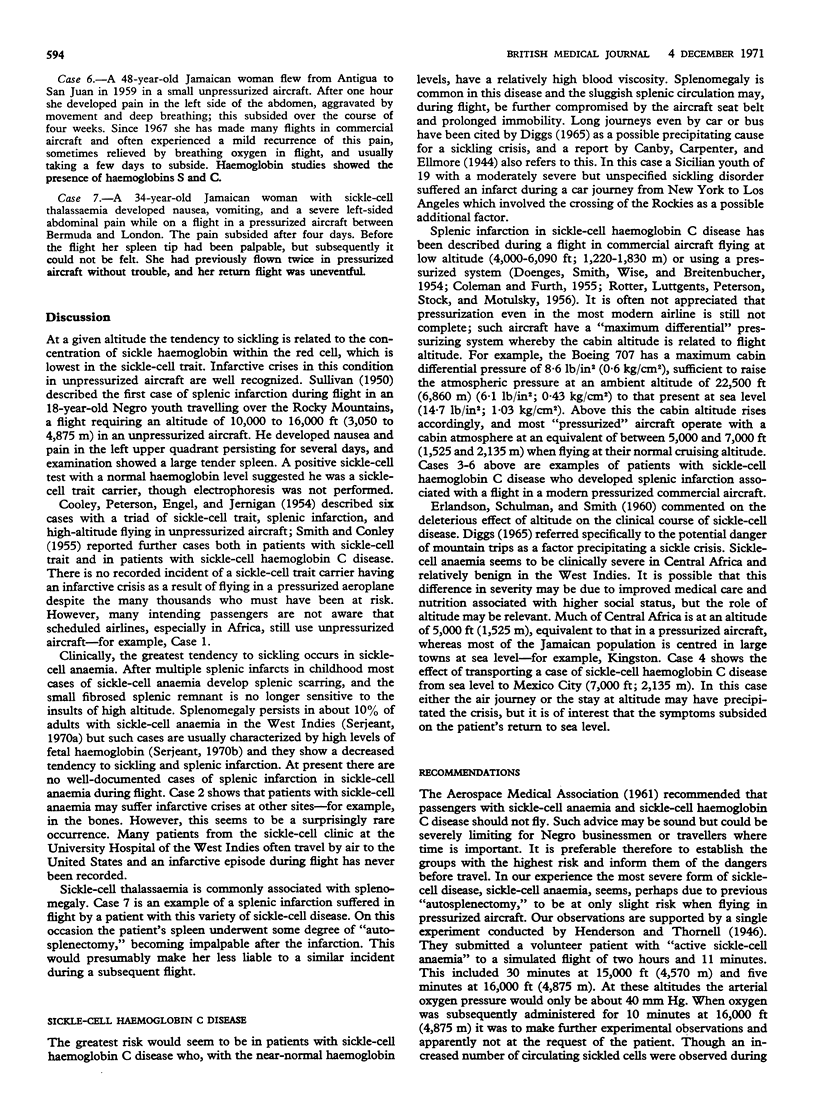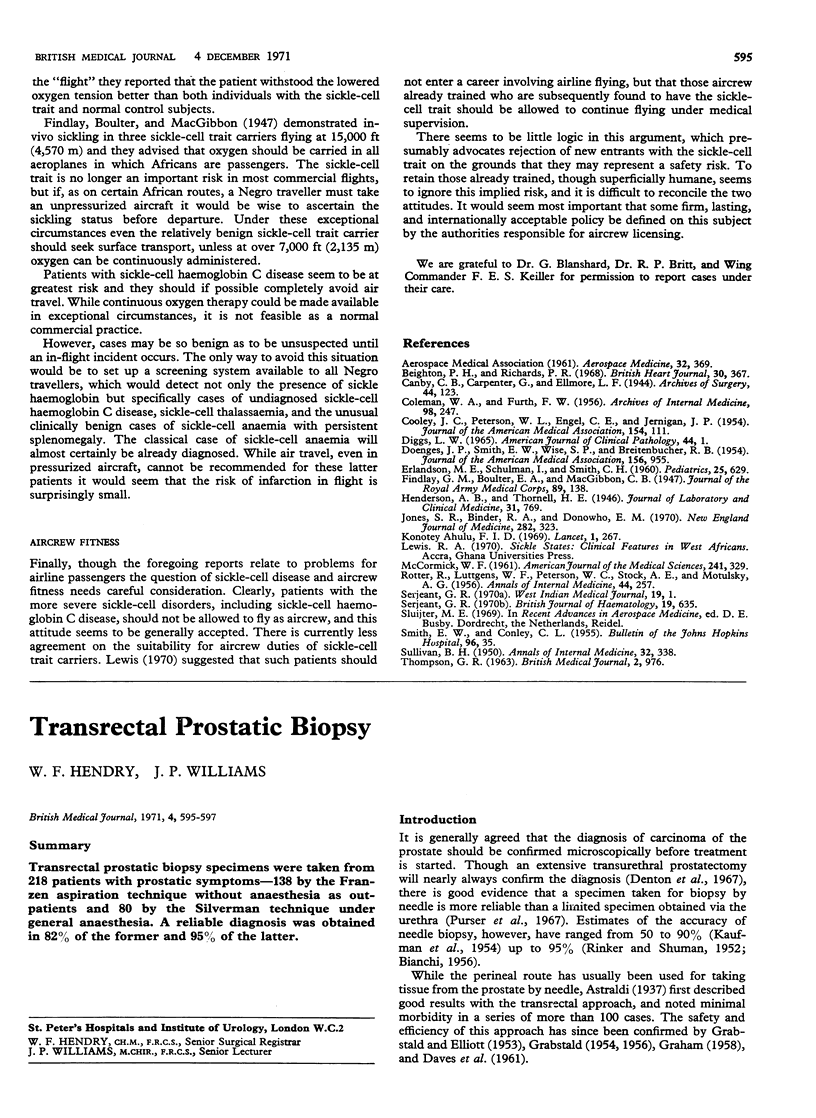Abstract
High altitude seemed to be responsible for seven recent cases of sickling crisis. People with sickle-cell trait are at risk if they fly in unpressurized aircraft, which are used for many local air services. Those with sickle-cell haemoglobin C disease should avoid air travel even in pressurized aircraft. Possibly as a result of “autosplenectomy,” patients with sickle-cell anaemia seem to be able to fly in pressurized aircraft with little risk. All passengers and aircrew who might have some form of sickle-cell disease should be screened before flight.
Full text
PDF


Selected References
These references are in PubMed. This may not be the complete list of references from this article.
- Beighton P. H., Richards P. R. Cardiovascular disease in air travellers. Br Heart J. 1968 May;30(3):367–372. doi: 10.1136/hrt.30.3.367. [DOI] [PMC free article] [PubMed] [Google Scholar]
- COLEMAN W. A., FURTH F. W. Splenic infarction in a patient with sickle-cell-hemoglobin-c disease; report of a case occurring following air travel. AMA Arch Intern Med. 1956 Aug;98(2):247–249. doi: 10.1001/archinte.1956.00250260121012. [DOI] [PubMed] [Google Scholar]
- COOLEY J. C., PETERSON W. L., ENGEL C. E., JERNIGAN J. P. Clinical triad of massive splenic infarction, sicklemia trait, and high altitude flying. J Am Med Assoc. 1954 Jan 9;154(2):111–113. doi: 10.1001/jama.1954.02940360009003. [DOI] [PubMed] [Google Scholar]
- DOENGES J. P., SMITH E. W., WISE S. P., 3rd, BREITENBUCHER R. B. Splenic infarction following air travel and associated with the sickling phenomenon. J Am Med Assoc. 1954 Nov 6;156(10):955–957. doi: 10.1001/jama.1954.02950100031010a. [DOI] [PubMed] [Google Scholar]
- ERLANDSON M. E., SCHULMAN I., SMITH C. H. Studies on congenital hemolytic syndromes. III. Rates of destruction and production of erythrocytes in sickle cell anemia. Pediatrics. 1960 Apr;25:629–644. [PubMed] [Google Scholar]
- Jones S. R., Binder R. A., Donowho E. M., Jr Sudden death in sickle-cell trait. N Engl J Med. 1970 Feb 5;282(6):323–325. doi: 10.1056/NEJM197002052820607. [DOI] [PubMed] [Google Scholar]
- Konotey-Ahulu F. I. Anaesthetic deaths and the sickle-cell trait. Lancet. 1969 Feb 1;1(7588):267–268. doi: 10.1016/s0140-6736(69)91287-2. [DOI] [PubMed] [Google Scholar]
- ROTTER R., LUTTGENS W. F., PETERSON W. L., STOCK A. E., MOTULSKY A. G. Splenic infarction in sicklemia during airplane flight: pathogenesis, hemoglobin analysis and clinical features of six cases. Ann Intern Med. 1956 Feb;44(2):257–270. doi: 10.7326/0003-4819-44-2-257. [DOI] [PubMed] [Google Scholar]
- SMITH E. W., CONLEY C. L. Sicklemia and infarction of the spleen during aerial flight; electrophoresis of the hemoglobin in 15 cases. Bull Johns Hopkins Hosp. 1955 Jan;96(1):35–41. [PubMed] [Google Scholar]
- SULLIVAN B. H., Jr Danger of airplane flight to persons with sicklemia. Ann Intern Med. 1950 Feb;32(2):338–342. doi: 10.7326/0003-4819-32-2-338. [DOI] [PubMed] [Google Scholar]
- Serjeant G. R. Irreversibly sickled cells and splenomegaly in sickle-cell anaemia. Br J Haematol. 1970 Nov;19(5):635–641. doi: 10.1111/j.1365-2141.1970.tb01647.x. [DOI] [PubMed] [Google Scholar]


